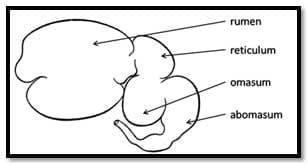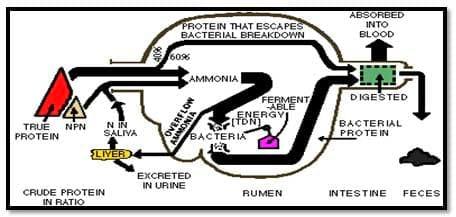A Pocket Guide To Ruminant Digestion
Published: December 12, 2013
By: Dr Farhan Ali, Doctor of Veterinary Medicine (BZU Multan)
THE RUMINANT DIGESTIVE SYSTEM
“Ruminant can convert Roughes into useful products “
How to achieve this?
Due to Different compartments of digestive tract.
- Reticulum
- Rumen
- Omasum
- Abomasum
Reticulum
- Flask-shaped compartment with a "honeycomb" appearance.
- Causes the regurgitation of ingesta during rumination.
Rumen
- It is a large fermentation chamber ( cattle :125 liters)
- High population of micro-organisms, mainly bacteria, but also protozoa.
- Rumen Lined with projection (1cm>) Called Rumen Papillae.
- Absorption of Byproducts through Bacterial fermentation (VFAs).
- Bacteria secrete the enzymes necessary for cellulose degradation that ruminants are able to utilize roughage.
- Saliva is the major buffer for helping to maintain a rumen pH between 6.2 and 6.8 for optimum digestion of forages and feedstuffs.
Omasum
- Contains numerous laminae that help grind ingesta.
- The removal of fluid from the ingesta on their way to the abomasum.
Abomasum
- It secretes the gastric juices which aid indigestion.
- Have PH range of 2,0 to 2,5.low pH facilitates initial protein breakdown, and kills the bacteria which have spilled over from the rumen.
 MACRONUTRIENTS
MACRONUTRIENTSMacronutrients are nutrients that provide calories or energy.
Nutrients are substances needed for growth, metabolism, and for other body functions.
- Carbohydrate
- Protein
- Fat
- Carbohydrate provides 4 calories per gram.
- Protein provides 4 calories per gram.
- Fat provides 9 calories per gram.
Importance of Carbohydrates
- All of the tissues and cells in our body can use glucose for energy.
- Carbohydrates are needed for the central nervous system, kidneys, brain, muscles to function properly.
- Carbohydrates are important in intestinal health and waste elimination.
- Carbohydrates found in starchy foods (like grain and potatoes), fruits, milk, and yogurt. Other foods like vegetables, beans, nuts, seeds and cottage cheese contain less amount carbohydrates.
Digestion and absorption of Carbohydrates
Primary Energy Source for Ruminants

The volatile fatty acids are absorbed from the rumen into the blood stream and transported to body tissues. The cow derives 50 to 70 percent of its energy from the volatile fatty acids produced in the rumen.

Microbial digestion of carbohydrate in rumen

Importance of PROTEIN
- Growth
- Tissue repair
- Immune function
- Making essential hormones and enzymes
- Protein is found in meats, poultry, fish, meat substitutes, cheese, milk, nuts, and legumes.
Digestion and absorption of Protien

About 60% Protein fed to animal is degraded in rumen the remaining 40%escape to abomasums.

Importance of Fat
- Normal growth and development
- Energy (fat is the most concentrated source of energy)
- Absorbing certain vitamins ( like vitamins A, D, E, K, and carotenoids)
- Providing cushioning for the organs
Saturated fat (found in foods like meat, butter, lard, and cream).
unsaturated fat (found in foods like olive oil, avocados, nuts, and canola oil)
Fat digestion.
- Most of the digestion and absorption of fat occurs in the small intestine.
- Rumen micro-organisms change unsaturated fatty acids to saturated acids through the addition of hydrogen molecules. Thus, more saturated fat is absorbed by cows than by simple-stomach animals.
- Feeding large quantities of unsaturated fatty acids can be toxic to rumen bacteria, depress fiber digestion, and lower rumen pH.
Vitamin Digestion
- The rumen micro-organisms manufacture all of the B vitamins and vitamin K.
- Vitamin synthesis in the rumen is sufficient for growth and maintenance.
- Niacin (B3) and thiamine (B1) may be needed under stress conditions.
Digestive Disorder
1) BLOAT
“Excessive accumulation of gas in the rumen”.
Frothy bloat (Pasture bloat)
- The daily production of gas, principally carbon dioxide, and methane, is about 800 litres in adult cattle.
- Some legumes (clover and lucerne, especially) have high bloat potentials
- Much can be done to prevent bloat, e.g. roughage, especially dry hay, should be fed before, or during, the grazing of lush, immature legume pasture. This will reduce the risk of bloat occurring. The dry roughage stimulates salivation, and sufficient saliva will help prevent bloat
Frothy bloat occurs when the rate of foam formation is greater than the rate of foam breakdown, The foam persists, , causing an increase in the volume of ruminal digesta. so it difficult for the animal to clear digesta from the entrance of the oesophagus (the cardia).
Treatment of bloat
Genuine turpentine, at a rate of 1 ml/kg body mass, administered by mouth
Free gas bloat
Gases of rumen fermentation are trapped due to esophageal obstruction.
Treatment
Use of a trocar.
2) Acidosis
- The production of short-chain fatty acids in the rumen is directly related to the various types, and number, of bacteria and protozoa that make up the rumen microbial population.
- Some Bacteria Digest cellulose, hemicellulose or some digest starch only or some bacteria digest both.
- When the ration is changed from predominantly roughage to a grain ration, the population shifts towards more starch-digesters. Starch-digesting bacteria produce more prop ionic acid .
- A high grain-content ration will result in a rapid increase in rumen acidity, due to the rapid production of short-chain fatty acids.
- The starch-digesting bacteria, Streptococcus ovis, increase rapidly, and 80 to 85% of the acid produced by this species is lactic acid. At the same time, the rumen pH falls considerably, to approximately 5, and lower, and there is a tremendous increase in histamine that could lead to laminitis.
- Small quantities of lactic acid are normally efficiently converted to propionic acid, but when excessive quantities of lactic acid are produced they accumulate in the rumen, and eventually are absorbed via the rumen wall into the bloodstream.
- Acidosis seems to appear more often during the summer months.
- 300 g of magnesium oxide powder use.
Related topics:
Authors:
Recommend
Comment
Share
21 de diciembre de 2013
Feed first enters in Ruman. Ruman is the first compartment than reti comes. Feed goes in Ruman, returns back for regurgitation (mastication and swallowing)and goes back to reyticolum
Recommend
Reply
19 de enero de 2016
Could you please give more information about the use of 300 gr of magnesium oxide powder to treat acidosis?
Why powder form and do you think that 300 gr/ cows/day is not very high quantities that have a laxative effect on ruminants?
Recommend
Reply
11 de febrero de 2014
I think this is a good start to a practical guide to the ruminant digestive system and some common adverse conditions. I agree with the need to emphasize plant fiber digestion. I also think that making a more detailed description of the plant tissue and cell components would add to the level of understanding ruminant digestion for the reader.
Recommend
Reply
Cargill
14 de enero de 2014
I also agree with Mr. Raza. Beside this, I would like to say, that roughage digestion should be mentioned first than carbohydrate and protein, as ruminants are mainly fibre eating animals.
It is not clear, whether it is meant for some educational program to vet students or farmers. If it is for farmers, rather than sticking to anatomy and physiology, this should contain feeding guidelines also.
Recommend
Reply

Would you like to discuss another topic? Create a new post to engage with experts in the community.









.jpg&w=3840&q=75)